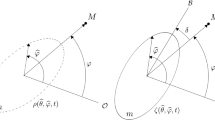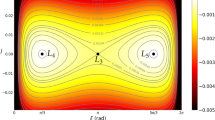Abstract
This paper deals with the application of the creep tide theory (Ferraz-Mello, Celest Mech Dyn Astron 116:109, 2013a) to the rotation of close-in satellites, Mercury, close-in exoplanets, and their host stars. The solutions show different behaviors with two extreme cases: close-in giant gaseous planets with fast relaxation (low viscosity) and satellites and Earth-like planets with slow relaxation (high viscosity). The rotation of close-in gaseous planets follows the classical Darwinian pattern: it is tidally driven toward a stationary solution that is synchronized with the orbital motion when the orbit is circular, but if the orbit is elliptical, it has a frequency larger than the orbital mean motion. The rotation of rocky bodies, however, may be driven to several attractors whose frequencies are \(1/2,1,3/2,2,5/2,\ldots \) times the mean motion. The number of attractors increases with the viscosity of the body and with the orbital eccentricity. The final stationary state depends on the initial conditions. The classical example is Mercury, whose rotational period is 2/3 of the orbital period (3/2 attractor). The planet behaves as a molten body with a relaxation that allowed it to cross the 2/1 attractor without being trapped but not to escape being trapped in the 3/2 one. In that case, the relaxation is estimated to lie in the interval \(4.6< \gamma < 27 \times 10^{-9}\,{\mathrm{s}}^{-1}\) (equivalent to a quality factor roughly constrained to the interval \(5<Q<50\)). The stars have a relaxation similar to the hot Jupiters, and their rotation is also driven to the only stationary solution existing in these cases. However, solar-type stars may lose angular momentum due to stellar wind, braking the rotation and displacing the attractor toward larger periods. Old, active host stars with big close-in companions generally have rotational periods larger than the orbital periods of the companions. The paper also includes a study of energy dissipation and the evolution of orbital eccentricity.














Similar content being viewed by others
Notes
Supersynchronous means that the angular rotation velocity is larger than the mean motion, i.e., the rotation period is smaller than the orbital period. It is often referred to in the literature as a pseudosynchronous solution.
The tidal torques derived in theories based on energy dissipation due to tides instead of lags (e.g., Hut 1981; Eggleton et al. 1998) are the same as in Darwinian theories with lags proportional to frequencies. They also predict pseudosynchronous stationary rotation with \(\varOmega \simeq n(1+6e^2)\).
The Cayley functions introduced here correspond to degree 3 in a / r – since \(\epsilon _\rho \propto (a/r)^3\). More general definitions, corresponding to higher powers, will be introduced in Sect. 7. These functions are equivalent to the Hansen coefficients preferred by other authors, and the equivalence is given by \(E^{(n)}_{q,p}=X^{-n,q}_{2-p}\) (Correia et al. 2014).
This definition of \(\nu \) is obviously different from that adopted in pure Keplerian approaches (as in Paper I), where the possible precessions of the node and pericenter were not considered, i.e., \({\dot{\varpi }}=0\). (NB: Here, \(n={\dot{\ell }}\) is the anomalistic mean motion.)
We do not use the words resonance and capture because the dynamics of this approach is not pendulumlike. Rather, we have attractors and basins of attraction.
In fact, to obtain the maps, a first-order integrator would be enough. \(y'\) is too small, and we are allowed to assume that y is constant (that is, \(\sigma _k\) is constant) on the right-hand side and just integrate over one cycle of the periodic terms, that is,
$$\begin{aligned} \varDelta \left( \frac{\nu }{n}\right) =-\frac{3 \pi M \overline{\epsilon }_\rho }{(M+m)}\sum _{k\in \mathbb {Z}} E_{2,k}^2 \sin 2{\overline{\sigma }}_k . \end{aligned}$$The results are almost the same as those shown. This equation is, in fact, just a translation of Eq. (37) to the used adimensional variables.
To obtain the dissipation in the other body, the equations are the same, but with the meanings of \({\mathsf {M}}\) and \({\mathsf {m}}\) interchanged.
References
Bambusi, D., Haus, E.: Asymptotic stability of synchronous orbits for a gravitating viscoelastic sphere. Cel. Mech. Dynam. Astron. 114, 255–277 (2012)
Bouvier, J., Forestini, M., Allain, S.: The angular momentum evolution of low-mass stars. Astron. Astrophys. 326, 10231043 (1997)
Bouvier, J.: Observational studies of stellar rotation. EAS Publ. Series 62, 143–168 (2013)
Carone, L.: Tidal interactions of short-period extrasolar transit planets with their host stars: Constraining the elusive stellar tidal dissipation factor. Diss. Universität zu Köln (2012)
Castillo-Rogez, J.C., Efroimsky, M., Lainey, V.: The tidal history of Iapetus. Spin dynamics in the light of a refined dissipation model. J. Geophys. Res. 116, E9008 (2011)
Cayley, A.: Tables of developments of functions in the theory of elliptic motion. Mem. R. Astron. Soc. 29, 191–306 (1861)
Chandrasekhar, S.: Ellipsoidal Figures of Equilibrium, Chap. VIII. Yale University Press, New Haven (1969)
Correia, A.C.M., Boué, G., Laskar, J., Rodríguez, A.: Deformation and tidal evolution of close-in planets and satellites using a Maxwell viscoelastic rheology. Astron. Astrophys. 571, A50 (2014)
Darwin, G.H.: On the bodily tides of viscous and semi-elastic spheroids and on the ocean tides upon a yielding nucleus. Philos. Trans 170, 1–35 (1879)
Darwin, G.H.: On the secular change in the elements of the orbit of a satellite revolving about a tidally distorted planet. Philos. Trans. 171, 713–891 (1880)
Efroimsky, M., Lainey, V.: Physics of bodily tides in terrestrial planets and the appropriate scales of dynamical evolution. J. Geophys. Res. 112, E12003 (2007)
Efroimsky, M., Williams, J.G.: Tidal torques. I. A critical review of some techniques. Cel. Mech. Dynam. Astron. 104, 257–289 (2009)
Efroimsky, M.: Bodily tides near spin-orbit resonances. Cel. Mech. Dynam. Astron. 112, 283–330 (2012)
Efroimsky, M., Makarov, V.V.: Tidal dissipation in a homogeneous spherical body. I. Methods. Astrophys. J. 795, 6 (2014)
Eggleton, P.P., Kiseleva, L.G., Hut, P.: The equilibrium tide model for tidal friction. Astrophys. J. 499, 853–870 (1998)
Ferraz-Mello, S., Rodríguez, A., Hussmann, H.: Tidal friction in close-in satellites and exoplanets. The Darwin theory re-visited. Celest. Mech. Dyn. Astron. 101, 171–201 (2008) and Errata: Celest. Mech. Dyn. Astr.: 104, 319–320 (2009). ( arXiv:0712.1156 astro-ph.EP)
Ferraz-Mello, S.: Dissipation and synchronization due to creeping tides. Comm. AAS/DDA 43, #8.06 (2012) ( arXiv:1204.3957 astro-ph.EP)
Ferraz-Mello, S.: Tidal synchronization of close-in satellites and exoplanets. A rheophysical approach. Celest. Mech. Dyn. Astron. 116, 109–140 (2013a)
Ferraz-Mello, S.: Earth tides in MacDonald’s model. arXiv:1301.5617 astro-ph.EP (2013b)
Ferraz-Mello, S.: Tidal Synchronization of Close-in Satellites and Exoplanets, Host Stars and Mercury. Comm. AAS/DDA 45, #202.01 (2014)
Ferraz-Mello, S., Folonier, H., Tadeu dos Santos, M., Csizmadia, Sz., do Nascimento, J. D., Pätzold, M.: Interplay of tidal evolution and stellar wind braking in the rotation of stars hosting massive close-in planets. Astrophys. J. (in press) (2015)
Ferraz-Mello, S.: The small and large lags of elastic and anelastic tides. The virtual identity of two rheophysical theories. Astron. Astrophys. (in press) Preprint: arXiv:1504.04609 (2015)
Folonier, H., Ferraz-Mello, S., Kholshevnikov, K.V.: The flattenings of the layers of rotating planets and satellites deformed by a tidal potential. Celest. Mech. Dyn. Astron. 122, 183–198 (2015). Preprint: arXiv:1503.08051
Hatzes, A.P.: An investigation into the radial velocity variability of GJ 581—on the significance of GJ 581g. Astron. Nachr. 334, 616–624 (2013)
Hut, P.: Tidal evolution in close binary systems. Astron. Astrophys. 44, 126140 (1981)
Irwin, J., Berta, Z.K., Burke, C., Charbonneau, D., Nutzman, P., et al.: On the angular momentum evolution of fully convective stars: rotation periods for field M-dwarfs from the MEarth transit survey. Astrophys J. 727, 56 (2011)
Kaula, W.M.: Tidal dissipation by solid friction and the resulting orbital evolution. Rev. Geophys. 3, 661–685 (1964)
Lainey, V., Arlot, J.-E., Karatekin, Ö., Van Hoolst, T.: Strong tidal dissipation in Io and Jupiter from astrometric observations. Nature 459, 967–959 (2009)
Laskar, J.: Large scale chaos and marginal stability in the solar system. Celest. Mech. Dyn. Astron. 64, 115–162 (1996)
Levrard, B.: A proof that tidal heating in a synchronous rotation is always larger than in an asymptotic nonsynchronous rotation state. Icarus 193, 641643 (2008)
MacDonald, G.F.: Tidal friction. Rev. Geophys. 2, 467–541 (1964)
Makarov, V.V.: Conditions of passage and entrapment of terrestrial planets in spin–orbit resonances. Astrophys. J. 752, 73 (2012)
Makarov, V.V., Berghea, C.: Dynamical evolution and spin–orbit resonances of potentially habitable exoplanets. The case of GJ 667C. Astrophys. J. 780, 124 (2014)
Makarov, V.V., Berghea, C., Efroimsky, M.: Dynamical evolution and spin–orbit resonances of potentially habitable exoplanets: the case of GJ 581d. Astrophys J. 761, 183 (2012)
Makarov, V.V., Efroimsky, M.: No pseudosynchronous rotation for terrestrial planets and moons. Astrophys. J. 764, 27 (2013)
Makarov, V.V., Efroimsky, M.: Tidal dissipation in a homogeneous spherical body. II. Three examples: Mercury, Io, and Kepler-10 b. Astrophys. J. 795, 7 (2014)
Margot, J.-L., Peale, S., Jurgens, R., Slade, M., Holin, I.: Large longitude libration of Mercury reveals a molten core. Science 316, 710–714 (2007)
Melita, M.: Comm. Taller de Ciencias Planetárias, Córdoba (AR), Feb. 25-28 (2014)
Noyelles, B., Frouard, J., Makarov, V., Efroimsky, M.: Spin–orbit evolution of Mercury revisited. Icarus 241, 2644 (2014)
Ogilvie, G.I., Lin, D.N.C.: Tidal dissipation in rotating giant planets. Astrophys. J. 610, 477–509 (2004)
Ogilvie, G.I., Lin, D.N.C.: Tidal dissipation in rotating solar-type stars. Astrophys. J. 661, 1180–1191 (2007)
Pätzold, M., Endl, M., Csizmadia, Sz, Gandolfi, D., Jorda, L., et al.: Transiting exoplanets from the Corot space mission: XXIII; CoRoT-21b: a doomed large Jupiter arount a faint subgiant star. Astron. Astrophys. 545, A6 (2012)
Peale, S.J., Boss, A.P.: A spin–orbit constraint on the viscosity of a Mercurian liquid core. J. Geophys. Res. 82, 743–749 (1977)
Quintana, E.V., Barclay, T., Raymond, S.N., Rowe, J.F., Bolmont, E., et al.: An earth-sized planet in the habitable zone of a cool star. Science 344, 277–280 (2014)
Ray, R.D., Eanes, R.J., Lemoine, F.G.: Constraints on energy dissipation in the Earth’s body tide from satellite tracking and altimetry. Geophys. J. Int. 144, 471–480 (2001)
Remus, F., Mathis, S., Zahn, J.P., Lainey, V.: The surface signature of the tidal dissipation of the core in a two-layer planet. Astron. Astrophys. 573, A23 (2015)
Spohn, T.: Tides of Io. In: Wilhelm, H., et al. (eds.) Tidal Phenomena, pp. 345–377. Springer, Berlin (1997)
Tadeu dos Santos, M., Silva, G.G., Ferraz-Mello, S., Michtchenko, T.A.: A new analysis of the GJ581 extrasolar planetary system. Celest. Mech. Dyn. Astron. 113, 49–62 (2012)
Tisserand, F.: Traité de Mécanique Céleste. tome II, chap. VIII. Gauthier-Villars, Paris (1891)
Williams, J.G., Boggs, D.H., Yoder, C.F.: Lunar rotational dissipation in solid body and molten core. J. Geophys. Res. 106, 26933–27968 (2001)
Williams, J.G., Efroimsky, M.: Bodily tides near the 1:1 spin–orbit resonance. Correction to Goldreich’s dynamical model. Cel. Mech. Dynam. Astron. 114, 387–414 (2012)
Acknowledgments
This study was funded by the National Research Council, CNPq, Grant 306146/2010-0. The improvement of the text by Springer’s language editor is acknowledged.
Author information
Authors and Affiliations
Corresponding author
Additional information
The results of this paper were presented as Paper DDA 202.01 at the 45th Annual Meeting of the Division on Dynamical Astronomy of the American Astronomical Society, 2014, Philadelphia, USA.
Electronic supplementary material
Below is the link to the electronic supplementary material.
Rights and permissions
About this article
Cite this article
Ferraz-Mello, S. Tidal synchronization of close-in satellites and exoplanets: II. Spin dynamics and extension to Mercury and exoplanet host stars. Celest Mech Dyn Astr 122, 359–389 (2015). https://doi.org/10.1007/s10569-015-9624-5
Received:
Revised:
Accepted:
Published:
Issue Date:
DOI: https://doi.org/10.1007/s10569-015-9624-5




